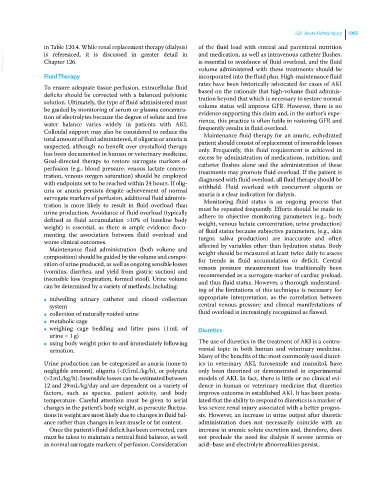Page 1157 - Clinical Small Animal Internal Medicine
P. 1157
120 Acute Kidney Injury 1095
in Table 120.4. While renal replacement therapy (dialysis) of the fluid load with enteral and parenteral nutrition
VetBooks.ir is referenced, it is discussed in greater detail in and medication, as well as intravenous catheter flushes,
is essential to avoidance of fluid overload, and the fluid
Chapter 126.
Fluid Therapy volume administered with these treatments should be
incorporated into the fluid plan. High‐maintenance fluid
rates have been historically advocated for cases of AKI
To ensure adequate tissue perfusion, extracellular fluid based on the rationale that high‐volume fluid adminis-
deficits should be corrected with a balanced polyionic tration beyond that which is necessary to restore normal
solution. Ultimately, the type of fluid administered must volume status will improve GFR. However, there is no
be guided by monitoring of serum or plasma concentra- evidence supporting this claim and, in the author’s expe-
tion of electrolytes because the degree of solute and free rience, this practice is often futile in restoring GFR and
water balance varies widely in patients with AKI. frequently results in fluid overload.
Colloidal support may also be considered to reduce the Maintenance fluid therapy for an anuric, euhydrated
total amount of fluid administered, if oliguria or anuria is patient should consist of replacement of insensible losses
suspected, although no benefit over crystalloid therapy only. Frequently, this fluid requirement is achieved in
has been documented in human or veterinary medicine. excess by administration of medications, nutrition, and
Goal‐directed therapy to restore surrogate markers of catheter flushes alone and the administration of these
perfusion (e.g., blood pressure, venous lactate concen- treatments may promote fluid overload. If the patient is
tration, venous oxygen saturation) should be employed diagnosed with fluid overload, all fluid therapy should be
with endpoints set to be reached within 24 hours. If olig- withheld. Fluid overload with concurrent oliguria or
uria or anuria persists despite achievement of normal anuria is a clear indication for dialysis.
surrogate markers of perfusion, additional fluid adminis- Monitoring fluid status is an ongoing process that
tration is more likely to result in fluid overload than must be repeated frequently. Efforts should be made to
urine production. Avoidance of fluid overload (typically adhere to objective monitoring parameters (e.g., body
defined as fluid accumulation >10% of baseline body weight, venous lactate concentration, urine production)
weight) is essential, as there is ample evidence docu- of fluid status because subjective parameters, (e.g., skin
menting the association between fluid overload and turgor, saliva production) are inaccurate and often
worse clinical outcomes. affected by variables other than hydration status. Body
Maintenance fluid administration (both volume and
composition) should be guided by the volume and compo- weight should be measured at least twice daily to assess
for trends in fluid accumulation or deficit. Central
sition of urine produced, as well as ongoing sensible losses venous pressure measurement has traditionally been
(vomitus, diarrhea, and yield from gastric suction) and recommended as a surrogate marker of cardiac preload,
insensible loss (respiration, formed stool). Urine volume and thus fluid status. However, a thorough understand-
can be determined by a variety of methods, including:
ing of the limitations of this technique is necessary for
indwelling urinary catheter and closed collection appropriate interpretation, as the correlation between
●
system central venous pressure and clinical manifestations of
collection of naturally voided urine fluid overload is increasingly recognized as flawed.
●
metabolic cage
●
weighing cage bedding and litter pans (1 mL of
● Diuretics
urine = 1 g)
using body weight prior to and immediately following The use of diuretics in the treatment of AKI is a contro-
●
urination. versial topic in both human and veterinary medicine.
Many of the benefits of the most commonly used diuret-
Urine production can be categorized as anuria (none to ics in veterinary AKI, furosemide and mannitol, have
negligible amount), oliguria (<0.5 mL/kg/h), or polyuria only been theorized or demonstrated in experimental
(>2 mL/kg/h). Insensible losses can be estimated between models of AKI. In fact, there is little or no clinical evi-
12 and 29 mL/kg/day and are dependent on a variety of dence in human or veterinary medicine that diuretics
factors, such as species, patient activity, and body improve outcome in established AKI. It has been postu-
temperature. Careful attention must be given to serial lated that the ability to respond to diuretics is a marker of
changes in the patient’s body weight, as peracute fluctua- less severe renal injury associated with a better progno-
tions in weight are most likely due to changes in fluid bal- sis. However, an increase in urine output after diuretic
ance rather than changes in lean muscle or fat content. administration does not necessarily coincide with an
Once the patient’s fluid deficit has been corrected, care increase in uremic solute excretion and, therefore, does
must be taken to maintain a neutral fluid balance, as well not preclude the need for dialysis if severe uremia or
as normal surrogate markers of perfusion. Consideration acid–base and electrolyte abnormalities persist.

